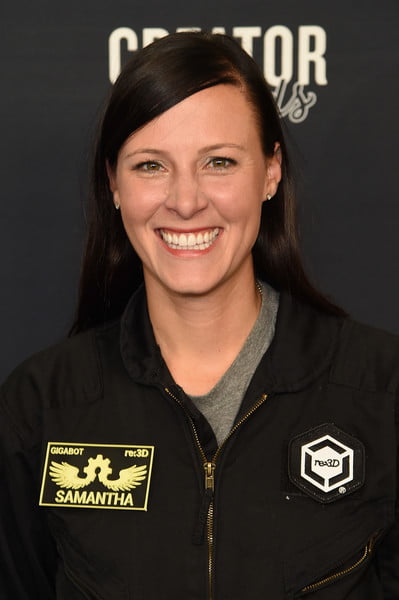If you’re in London between now and February 2020, there’s an exhibition at the Design Museum called Moving to Mars, where artists imagine a future on the Red Planet. It’s an inspiring look at humanity’s potential next planet, but clearly in the realm of the fantastic in parts.
What are we planning, here on Earth to get us ready for next-stage planetary exploration and terraforming tasks? One thing’s clear: we’ll have to build out habitats with materials on hand. There’s no Amazon Prime Mars (yet) for Earth-to-Mars shipments, which is where industrial-scale 3D printing comes into play.
One company that might help with that effort is Houston-based re:3D. With the tagline “Think BIG, Print HUGE,” re:3D makes the Gigabot, the world’s largest, affordable, industrial 3D printer, which is now available in 50-plus countries. It donates one Gigabot for every 100 sold commercially to a group or individuals making a difference in their community. It’s committed to turning plastic waste into 3D-printed projects and is still involved in post-disaster efforts in Puerto Rico.
We spoke with re:3D’s Co-Founder and CEO Samantha Snabes to find out more. Here are edited and condensed excerpts from our conversation.
I’ve read that re:3D started in 2013 when you and co-founder Matthew Fiedler were working at NASA Johnson Space Center, as social entrepreneurs in residence. How did the experience inspire you to start the company, and why?
[SS] While working at NASA I volunteered for Engineers Without Borders NASA JSC, a group of NASA astronauts, engineers, and scientists who wanted to translate what they were learning about solar energy, confined spaces, water quality, and water purification and take it to the developing world. I got the opportunity to travel to Nicaragua, Uganda, Rwanda, and saw a lot of frustrations around dependence on aid, imported goods, as well as high unemployment and the problem with plastic-based waste.

It gave Matthew and I the idea to use open-source 3D printers as a way for people to make their own stuff independently, using this plastic waste. The maker movement was just building momentum back then, but we realized industrial 3D printers were too expensive, and not modular, so we came up with a better solution, applied to Startup Chile, which offers $40,000 to start, or scale, your idea in Latin America, quit our jobs, moved to Chile, and started the company.
How do you turn plastic waste into reusable 3D-printed materials?
It’s not easy, but it is possible. Gigabot X can handle multiple types of reclaimed plastic, but there is still a lot of research to do. The easiest to cope with is plastic trim, known as “virgin plastic” because it’s clean and dry and we’re now working on printing from water bottles, investigating ways to separate the label, bottle cap, and adhesive via an optimum grinder, and drying and feeding solution, to characterize the size of flake that best extraudes.
Your Gigabot range can now print objects up to 30 times larger than competing desktop models. What’s the entry-level Gigabot functionality and cost?
Gigabot starts at just under $10,000 as a kit for a 2-foot cubed build volume filament-based 3D printer. Gigabot X, our pellet printer, starts at $15,000 for a similar build volume. Both platforms can go as large as your budget. We also offer contract printing, training, and design services.
Who are your main customers today and how are they using the Gigabot?
Our customers today use Gigabot for a variety of applications ranging from automotive to healthcare to construction. We’d love to hear what application your readers would like us to highlight next!
Do you have contracts with NASA? Are you working on the Mars program?
While we are not working on the Mars program directly, we do have many customers at multiple NASA campuses as well as contractors that serve the space agency.

Are they using the Gigabot for Mars prototypes?
What they use Gigabot for varies greatly. We’ve been honored to prototype the next-generation spacesuit, wheels for the lunar rover, and a drill for Martian research using VR in training simulations.
Alongside running re:3d, you’re also currently serving as a captain in the Mississippi National Guard, involved in disaster response where re:3d can help as part of getting those regions back on their feet again.
I think there is tremendous potential to leverage 3D printing in supply-constrained environments to include disaster response. We actually had a chance to test this theory in 2017 when hurricanes Irma and Maria passed over our Puerto Rico office. Afterwards we offered Gigabot for free to any local with a need. You can view some of the stories we shared at re3d.org/stories. We think Gigabot X has particular value in these regions as there’s a plethora of discarded water bottles left behind after disaster response and the local community can then use them to start rebuilding their economy and lives.
While in Puerto Rico you gave your time as a mentor for the social enterprise accelerator program Parallel18. Tell us about that.
After participating in the Generation 4 cohort of P18, we were allowed to maintain a printer that we offer to participants for prototyping. We’ve also made a lot of logos for companies. Additionally we offer rapid prototype, design, and printing classes. For those looking to meet other print ninjas, we host monthly 3D-printing meetups.
You did a triple-major undergrad at University of Michigan-Dearborn (biology, international studies, hispanic studies), followed by an MBA. How did you get interested in this field?
I grew up in Detroit and I always wanted to be an astronaut. I went to every camp, seminar, and clinic that I could as a child to try to find out how to be an astronaut. From space camp, I had a list of astronauts and what state they were from. When I was at high school I used that list to find them in the White Pages, called them at their house and said: “I want to be an astronaut, what do I have to do to get there too?”
Wow. What advice did they give you?
They told me I had to go to college and to pick a career in science. So that’s what I did.
You’re still eligible, and qualified, to pursue this goal. Do you still apply?
Yes. I still apply to be an astronaut every couple years, along with 15,000 other Americans.
It’s a long shot but a great dream.
Yes, and I’m going to keep trying.
Your former startup, BioFlow Technology, was involved in DARPA-funded projects around stem cell research and tissue culture printing (artificial bone marrow). Is there any crossover with your work today—i.e. are you doing bio-printing?
No, we haven’t ventured into bio printing yet, but it’s something I am always thinking about. For example, I think it’s in the art of the possible to print sheets of skin on a customized version of Gigabot. As we mature and expand R&D this is something I’d like to explore.
What else are you working on in the R&D labs at re:3d?
We have a pellet printer that’s being refined, while delivering beta systems and getting feedback from the customers. We’re also learning we have to build some of the hardware that goes with it—like the shredder, dryer, and feeding system. So we’re focused on that right now. And we’re focused on doing pilots with municipalities and industries to see what jobs can be created and materials can be up-cycled.
And we only see ourselves going bigger. Printing out of shipping containers, going bigger, and learning about the customers that need our solutions. Hopefully we will be able to continue to characterize a LOT of types of plastic waste. There’s so much trash out there. We’re also building out 3D printing education modules, and studying economic opportunity. We’re becoming more academic, publishing and sharing with the community, so we can learn together. Because we make mistakes along the way, and we want to share and learn with the community.
[“source=pcmag”]










